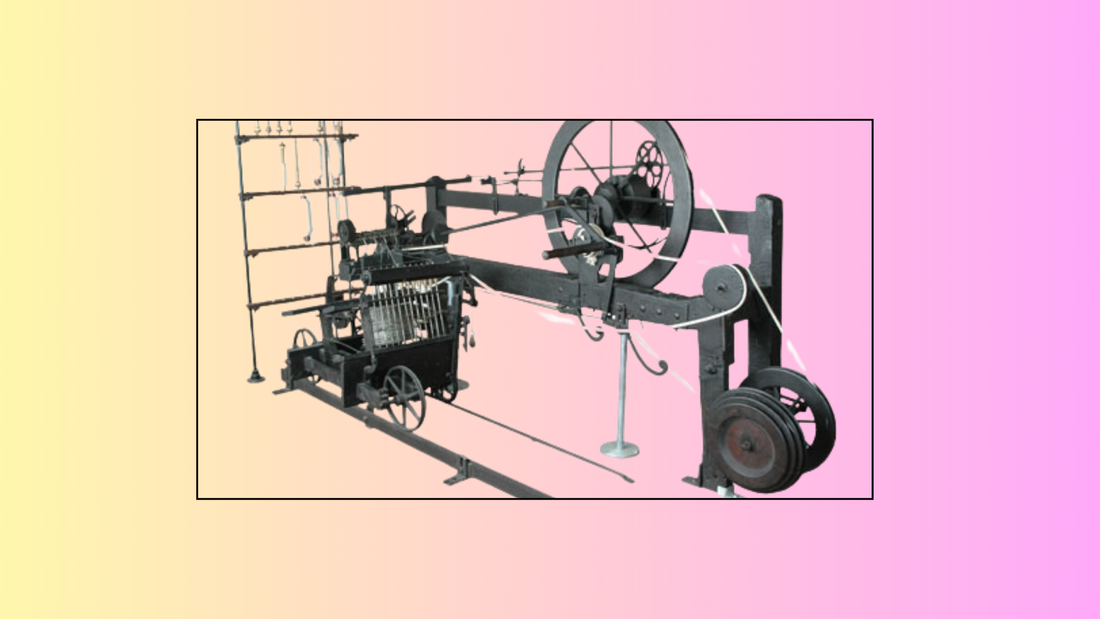Believe it or not, commercial spinning machines have only been around for a few hundred years. Early innovations focused primarily on spinning cotton using worsted techniques—producing smooth, dense yarns with fibers aligned in the same direction.
It wasn’t until around 1825, with the invention of the self-acting spinning mule, that woolen-spun yarn became commercially viable. This machine mimicked the long-draw technique used by hand-spinners—adding air and loft into the yarn, producing a lofty texture; one that’s wooly, warm, and delightfully light.
🧶 What Is Woolen-Spun Yarn?
Woolen-spun yarn is made from carded wool, where fibers are jumbled in multiple directions before spinning. This structure traps air inside the yarn, giving it softness, bounce, and superior insulation. After washing, the yarn blooms—swelling slightly and lightly felting to create a warm, cohesive fabric.
Best for:
- Cozy mittens
- Hats and cowls
- Traditional sweaters that need warmth without weight
🧵 Commercial Woolen-Spun Yarn Today
In the U.S., Bartlett Yarns is the last remaining mill producing woolen-spun yarn on a commercial scale. (It’s a bit of a secret, but we’re hoping to offer their beautiful yarn soon!)
Another excellent example is Shetland Spindrift from Jamieson’s of Shetland—a non-superwash, two-ply fingering-weight yarn perfect for stranded colorwork. Its woolen-spun construction creates just the right amount of grip and bloom during blocking, helping floats disappear behind felted fibers for added warmth and a polished finish.

With over 225 colors to choose from, it’s easy to get overwhelmed. That’s why we created From Shetland With Love—our monthly yarn club that delivers three curated Spindrift colorways each month. Whether you choose the yarn-only bundle or the deluxe box, you’ll build a versatile colorwork palette over time—without the guesswork.
🧵 What About Worsted-Spun Yarn?
If you've ever spotted silky, shiny combed top at a yarn festival—that’s the starting point for worsted-spun yarn. In this method, fibers are aligned in parallel before spinning, producing a smoother, denser yarn with wonderful stitch definition and drape.
Most yarns on the market today are technically semi-worsted—they offer more alignment than woolen-spun yarns but are less dense than a true worsted. These yarns are ideal for garments that benefit from drape, definition, and polish.
✨ A Perfect Summer Example: Twisp
One of our favorite examples of a semi-worsted yarn is Twisp, a plant-based blend from HiKoo.
Twisp is a sport-weight yarn spun for warmer days and lighter layers, blending:
- Soft Pima cotton for structure and smoothness
- Bamboo viscose for silky drape and luster
- Hemp for breathable strength

It’s an ideal choice for summer tees, transitional cardigans, and garments that move beautifully through the seasons.
💡 Choosing the Right Yarn for Your Project
Understanding the difference between woolen-spun and worsted-spun yarns helps you choose the right material for your project’s needs—whether that’s loft and warmth or structure and sheen.
Quick tip:
When comparing two yarns of the same weight (DK, fingering, etc.), check the label.
If both skeins weigh 100 grams, but one has 250 yards and the other only 230, the higher-yardage skein is likely woolen-spun—airier and loftier.
And remember:
👉 Woolen-spun yarn may look a little uneven at first, but stitches will beautifully even out after blocking.
Whether you’re drawn to the airy loft of woolen-spun yarns or the smooth drape of worsted, understanding how your yarn is spun adds another layer of intention to your making. It’s not just about the fiber—it’s about how that fiber moves, behaves, and transforms on your needles. We hope this guide helps you choose with confidence and curiosity. As always, we’re here to support your next cast-on—every stitch of the way.
Happy Knitting!


